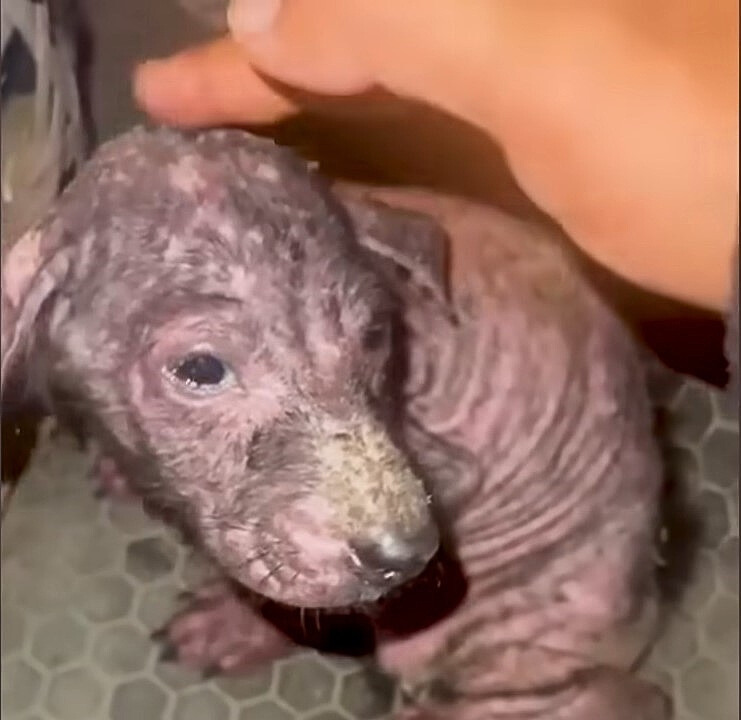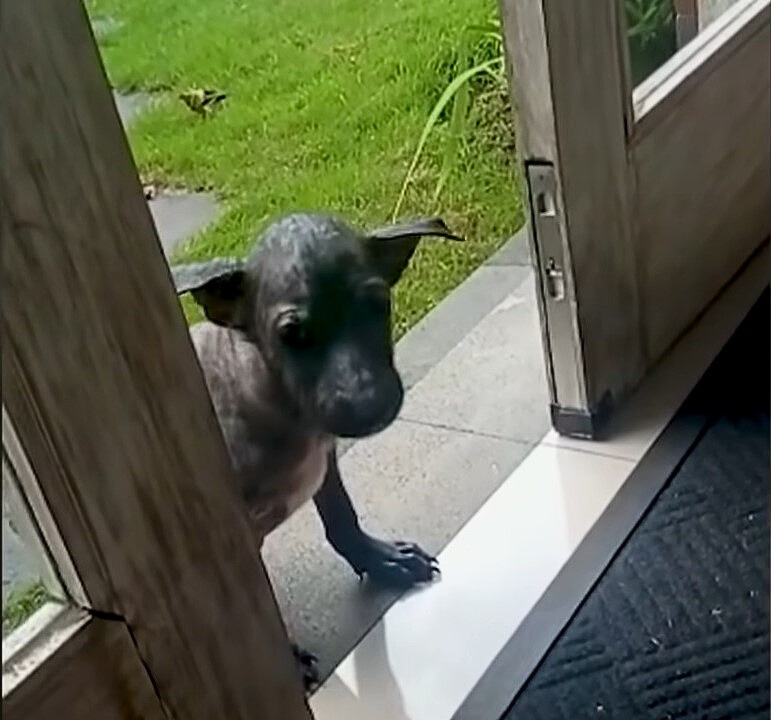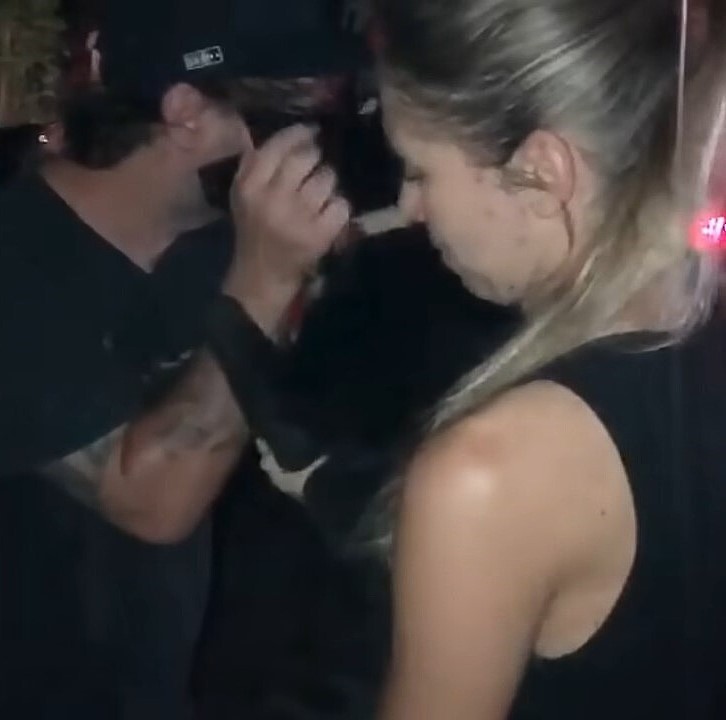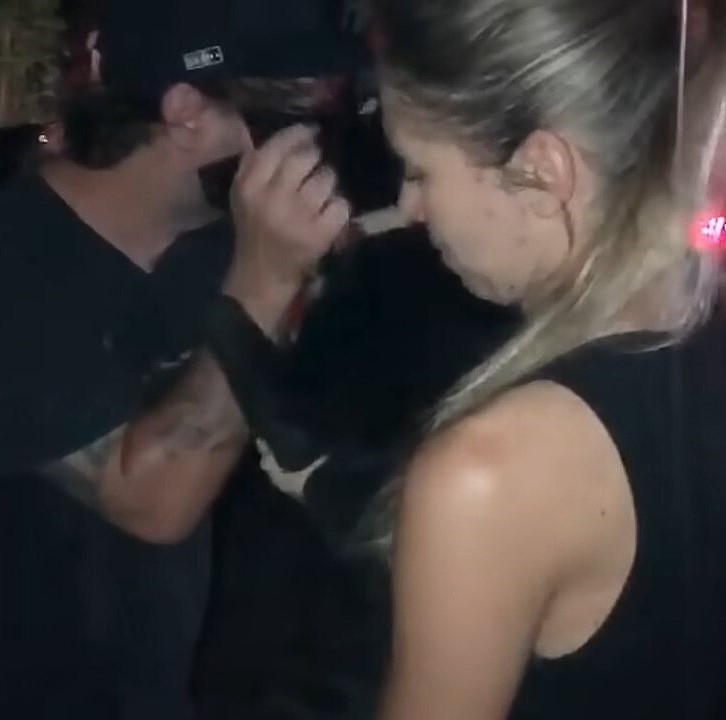I can’t understand how ruthless some dog owners can be toward their pups who trust them with their whole heart.
Chia, a small puppy, trusted humans, too, but they ended up hurting her feelings when they dumped her in the trash.
The pup was in a terrible state. The hairless skin on her skinny body was covered in scabies.
The puppy couldn’t hide the sadness that she felt in her heart.
Instead of being treasured and loved like she deserved, she found herself shaking with fear in a pile of trash.
The fur baby kept wondering why she was rejected and whether she would ever find the love that she craved.
A Good Samaritan Finds Her

When a good man noticed the small puppy curled up in the trash, he took her in his arms and cuddled her.
The sorrowful pup seemed glad to feel the loving touch of a human hand.
The Good Samaritan felt worried after he saw the bad condition the dog was in. He placed the sick pooch in a box and rushed her to the vet clinic.
The vet examined the puppy, later named Chia, and gave her the necessary treatment.
Chia’s skin began recovering, but her heart needed healing, too.
After spending weeks at the clinic, Chia moved in with a great foster family who received her with outstretched arms.
The sweet baby was terrified, and she couldn’t bring herself to enter their home.

Her fosters were extremely patient with her, and they used food to gain her trust. They gave her immense affection and showed the kindness that she needed.
It didn’t take long for Chia to feel at home.
After she made a full recovery, Chia met her foster sibling, who helped her build confidence and taught her how to be a dog.
Chia gained weight and became strong.
She transformed into a beautiful princess who felt fearless.

Her foster family took her on adventures, and the pooch realized how wonderful life can be.
A few months later, Chia found her forever family.
Before she moved in with her new parents, the adorable canine said goodbye to her wonderful fosters, who restored her faith in humanity.
The Beginning Of Sweet Life

Chia felt excited when she met her new family for the very first time. Her parents took her in their arms and covered her with kisses.
The pup instantly felt connected to them.
Chia was over the moon when she arrived at her forever home and met her doggy sister. The two dogs became the best of friends and spent a wonderful time playing together.
The puppy, who was once overwhelmed with fear, was now a picture of happiness. She finally found the loving parents that all dogs deserve.
I couldn’t be happier for the adorable girl.
Many thanks to the Good Samaritan who rescued Chia and to all the good humans who helped her find a wonderful forever home.
Ever noticed your furry friend engaging in a thorough grooming session, licking themselves with precision and focus? It’s a common sight in the world of dogs, but have you ever wondered why they do it? Dog owners often witness this self-grooming behavior, which seems almost instinctual to our canine companions. From a dog trainer’s perspective, observing this ritual provides insights into a dog’s natural tendencies and behaviors. Understanding why dogs engage in this repetitive act can offer a glimpse into their world and communication methods.
When your dog starts licking themselves, it’s like witnessing a secret language only they understand. Each lick, each movement, tells a story about their well-being, emotions, and even social interactions. As a seasoned dog trainer, decoding these subtle cues can unveil a deeper connection with your furry pal. So, the next time you catch your dog indulging in a grooming session, remember, there’s more to it than just staying clean.
Understanding Dog Behavior: Why Licking Occurs
The Science Behind Licking
When your dog licks itself, it’s not just grooming; there’s more to it than meets the eye. Licking is a natural behavior rooted in a dog’s ancestry. In the wild, mother dogs lick their puppies to stimulate them to breathe and to keep them clean. This instinct is carried over to domestic dogs, who lick themselves as a way of self-soothing and maintaining hygiene. It’s a behavior that’s deeply ingrained in their DNA.
Self-Grooming Habits
Dogs are meticulous self-groomers. Their tongues have special adaptations that help them clean hard-to-reach places and remove dirt and loose fur from their coats. Licking also has a cooling effect on dogs, similar to sweating in humans. By licking themselves, dogs can regulate their body temperature, especially in hot weather. So, the next time you see your furry friend licking away, know that it’s not just a grooming session but a multi-purpose behavior that serves various essential functions for their well-being.
Primary Reasons Dogs Lick Themselves
Health Maintenance
Dogs lick themselves not just to keep clean but also for health maintenance. Licking removes dirt, debris, and parasites from their fur, helping prevent skin infections and other health issues. It’s a natural way for dogs to ensure they stay healthy and free from external irritants.
Wound Healing
When a dog has a wound, licking can aid in the healing process. Their saliva contains enzymes that have antibacterial properties, which can help clean the wound and prevent infection. Additionally, licking increases blood flow to the area, promoting faster healing. However, excessive licking can also delay healing by irritating the wound, so it’s essential to monitor this behavior.
Stress and Anxiety Relief
Licking can be a self-soothing mechanism for dogs, especially in stressful situations. It releases endorphins that help them relax and feel calmer. Dogs may lick themselves more when they are anxious or trying to cope with a change in their environment. While occasional licking is normal, excessive licking can indicate underlying stress or anxiety that may require attention.
Recognizing Excessive Licking
Signs of Compulsive Behavior
If your dog excessively licks themselves, it could indicate compulsive behavior. Pay attention if your furry friend licks the same spot repeatedly, causing bald patches or skin irritation. Excessive licking can also lead to redness, swelling, or even sores on their skin. Watch out for any changes in your dog’s behavior, as this may be a sign of an underlying issue that needs addressing.
When to Consult a Veterinarian
It’s essential to consult a veterinarian if your dog’s licking behavior becomes obsessive. If the excessive licking persists despite your efforts to redirect or distract your pet, seeking professional advice is crucial. A veterinarian can help determine the root cause of the behavior, whether it’s due to physical discomfort, allergies, or psychological stress. Early intervention can prevent potential health issues and improve your dog’s well-being.
Preventing and Managing Excessive Licking
Training and Environmental Changes
If your dog is constantly licking itself, training and making some simple environmental adjustments can help. Start by distracting your dog with interactive toys or treats when you notice excessive licking. Redirecting their attention can break the licking cycle and provide mental stimulation. Try increasing exercise and playtime to reduce stress that may be causing the licking behavior. Additionally, create a calm and safe environment for your dog to minimize anxiety triggers that lead to excessive licking.
Medical Solutions and Therapies
When excessive licking persists despite training efforts, it may be time to consult a veterinarian for medical solutions and therapies. Your vet can evaluate if there are any underlying medical conditions causing the behavior. They may recommend medications to address allergies, skin irritations, or anxiety that could be triggering the excessive licking. Behavioral therapies such as desensitization techniques or alternative stress-relief methods might also be suggested to help manage your dog’s licking habits effectively.
Make sure to stay attentive to your dog’s licking habits and seek professional guidance if needed to ensure your furry companion stays healthy and happy.
Conclusion
So, there you have it – the reasons why dogs lick themselves go beyond just staying clean. From ancestral instincts to stress relief, licking plays various roles in a dog’s life. Whether it’s for grooming, healing wounds, or calming nerves, licking is a natural behavior that reflects your furry friend’s well-being. Remember, excessive licking could be a sign of something more serious, so keep an eye out for any unusual patterns. By understanding and addressing your dog’s licking habits, you can ensure they stay healthy and happy. So next time you see your pup indulging in a licking session, know that it’s just their way of taking care of themselves.
Frequently Asked Questions
Why do dogs lick themselves so much?
Dogs lick themselves for hygiene purposes, removing dirt and parasites to prevent infections. Licking also aids in wound healing due to antibacterial properties in saliva and increased blood flow. It serves as a stress relief mechanism by releasing endorphins, promoting relaxation in challenging situations.
How can I tell if my dog is excessively licking itself?
Excessive licking in dogs can be recognized by signs of compulsive behavior like repeated licking in the same spot leading to bald patches or skin irritation. If obsessive licking persists despite redirection efforts, consulting a veterinarian is important to rule out underlying physical discomfort, allergies, or psychological stress.
What can I do to manage my dog’s excessive licking habit?
To manage excessive licking, consider preventive measures like training, environmental changes, and seeking medical solutions and therapies when necessary. Distract your dog with interactive toys, increase exercise, and create a calm environment to reduce stress-related licking. Consult a veterinarian for underlying medical conditions, medications, and behavioral therapies to effectively manage your dog’s licking habits.
[no_toc]

Hey there, I’m Janet Brooks, a dog-loving student from California. I’m all about helping pups in need, especially those without homes. Me and my awesome friends work together to give shelter and love to stray dogs. Oh, and I also write blogs about dogs to share helpful info.